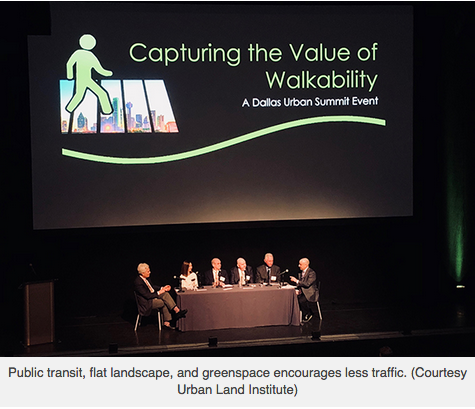ParkCitiesPeople
by Timothy Glaze · June 20, 2018

The Urban Land Institute has increased its presence in Dallas for the last month, as the nonprofit organization focuses on ways to make the city and its suburbs more walkable.
Officials estimate that nearly 98 percent of Dallas and Fort Worth’s incorporated land requires everyday car use to get from place to place. But by digging a little deeper, it’s possible to find pockets of land within the area that could be walkable urban places, said ULI volunteer Scott Polikov, who also works for Gateway Planning.
The use of public transportation in Dallas has skyrocketed in the past five years, leading more people to leave their cars at home and opt for trains – especially DART, which has several lines running through the city and its suburbs. That in turn is encouraging citizens to seek out walkable places, Polikov said.
“[Public transportation] is something that’s so great for this area, and the more people use it, the more of an impact we’ll start to see on our urban areas,” he said.
“There’s a real chance to have, in a way, a village-like feel depending on what we do.” -Scott Polikov”
In April and May, ULI gave presentations in Dallas on creating value in real estate development, the future of transit-oriented development, and a signature event focused on wellness, hotel development, multifamily use, and transportation. Presentations regarding the addition of more buildings all included use of greenspace.
One such area, the Statler Hotel at the intersection of Commerce and Harwood, was recently awarded the ULI’s Next Big Idea honor. The renovations will include a more environmentally-friendly building worth more than $200 million, and represents an effort by local architects to continue developing in Dallas while also maintaining environmental health.
Polikov pointed to the success some areas have enjoyed in terms of walkability – specifically, the Preston Hollow area and the Park Cities. Highland Park, for example, is a town catered to walking with its’ tight-knit neighborhoods, multiple parks, schools close to homes, and a centrally-located shopping center.
The town maintains its walkable attributes despite being in between two major highways and a just a short drive north from downtown.
“Dallas has the potential to be a strong walking city,” Polikov said. “There’s a real chance to have, in a way, a village-like feel depending on what we do in terms of greenspace. ULI works all over the country, and Dallas has as much potential as any other city.”
In the meantime, walkable developments are springing up all over North Texas, including Uptown, Plano, Richardson, and McKinney. It’s an attractive feature to current and prospective residents, Polikov said.
“The overall landscape of [Dallas and the surrounding areas] really allows for more walkable opportunities,” he said.

View article online
